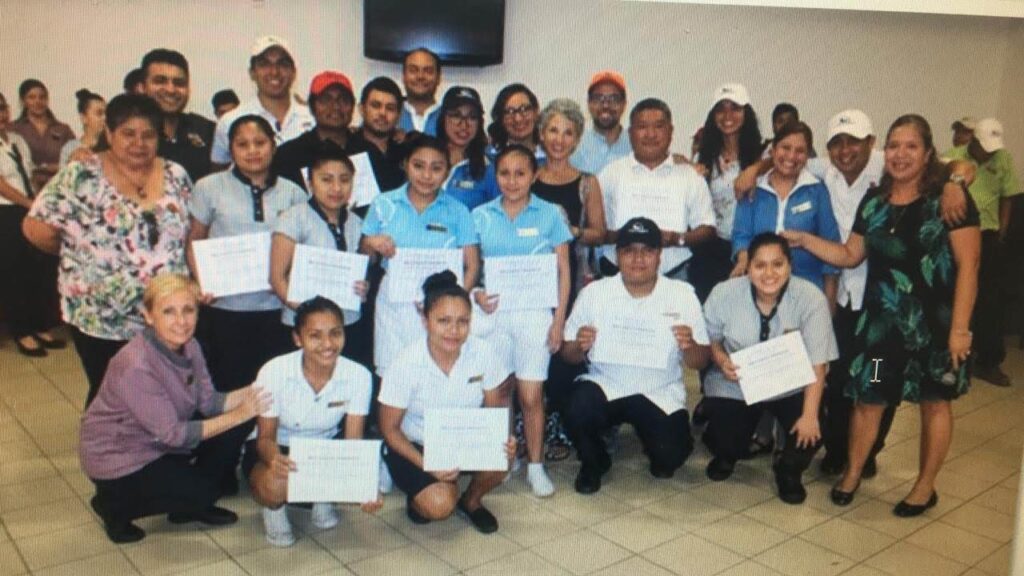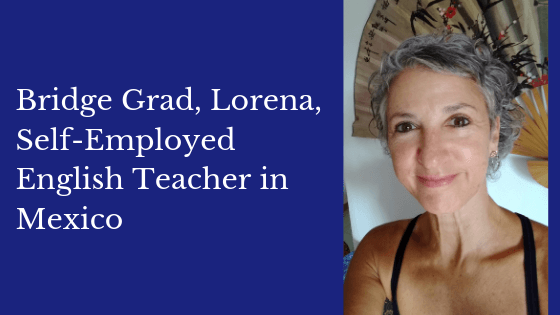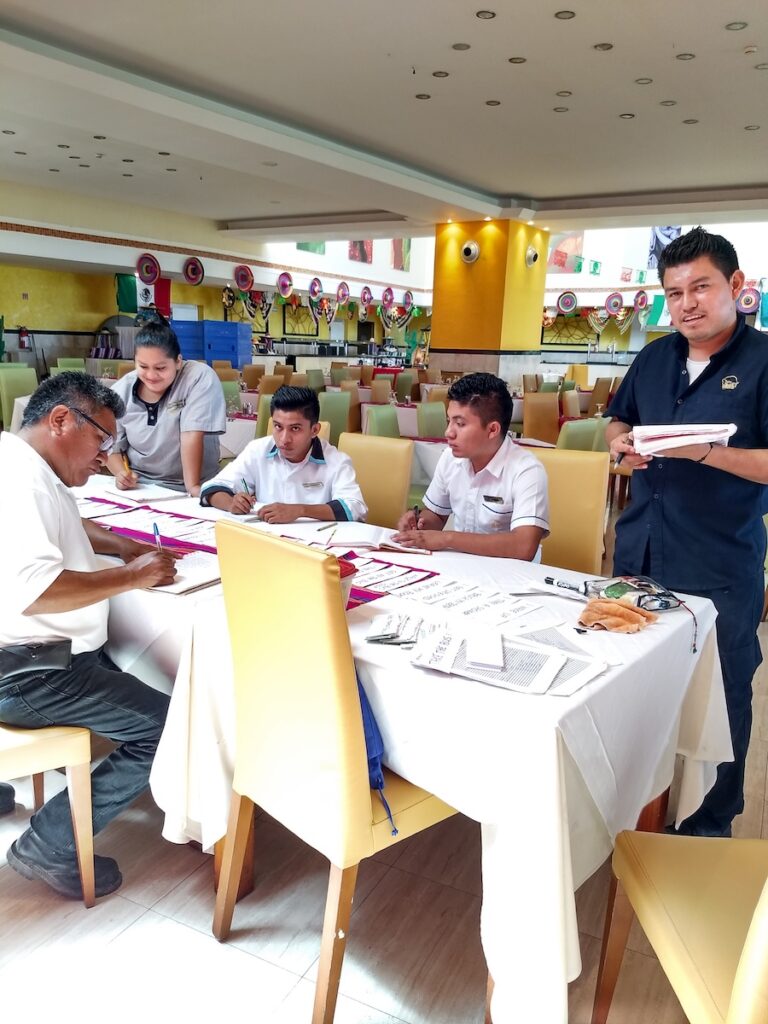Lorena Siegel, originally from Mexico, was already an experienced teacher when she took the BridgeTEFL Master Certificate course in order to qualify for better jobs. Since then, she’s leveraged her training and teaching experience to open her own English tutoring business, catering to the tourist sector in Playa del Carmen, Mexico.
Lorena, can you tell us a bit about yourself?
I was born in Mexico City and attended the American School Foundation (ASF), a bilingual school that focused on creativity and free thinking. Though my school was relatively liberal, I had a lot of problems due to dyslexia and ADD, which at the time was diagnosed as careless laziness. I was a B-, C+ student and I didn’t really enjoy school.
In 1980, I left ASF at the end of my Junior year and completed high school at the Country Day School in San Jose, Costa Rica. I then attended university in the U.S., Canada, and Mexico. I was fortunate to have some great teachers along the way who fomented my love of English and writing, and it is these two subjects that have helped me earn a living throughout my life.
What made you want to teach English and how did you get started?
When I was a little girl my favorite game with my friends was La Escuelita, or “little school.” I loved being the teacher, taking attendance, and checking my “students’” homework. When I was 9 years old, I taught our housekeeper how to read and encouraged her to finish the 6th grade.
I never planned on being a teacher and during my first few years of college I studied mass communications and psychology, but somehow, it’s the work that I’ve always felt the most comfortable doing.
Plus, my mother is a theatrical director and my father is a cartoonist, and both of their professions have influenced and added to my skills as a teacher.
You got certified via the BridgeTEFL 120-hour Master Certificate. How did you choose your TEFL course?
I was very fortunate to have found Bridge TEFL! Years back I had completed a course which was not recognized by the proper institutions. I felt as if I had been taken advantage of both financially and emotionally after all the hard work I had put into the course.
When I made the decision to get my TEFL certificate online, I spent a great deal of time reading loads of posts on a variety of sites and learned that there are many programs out there that forget about you once you’ve made your first payment. But when I read about Bridge, I found that it was accredited by The Accrediting Council for Continuing Education and Training (ACCET) and that many overseas schools accepted the Bridge certification.
I chose the 120-hour program because of the excellent price, and because this was the number of hours required by most of the online schools that I had looked into. Right from the start, the Bridge system worked! I never lost any of the essays or exams I had completed, and my online tutor, Katie Henley, was always available to answer my questions. Her comments on my work showed that she had read what I had written and had paid close attention to my ideas as well as the way I applied the information I’d learned from each module.
This attention to detail made it clear to me that Bridge is made up of a group of people who take teaching seriously. Their goal is to create well-rounded teachers with the necessary knowledge to teach English to foreign students.
Tell us about some of your teaching experience throughout your career.
Teaching at a language school in Mexico City
Besides teaching our housekeeper to read, I started teaching English to business people during a summer break in Mexico City when I was 18 years old. In my early 20s, I got a job with Berlitz Language Schools where I taught both English and Spanish. I learned their easy to follow methodology and I loved the simplicity of their technique for teaching a target language.
Teaching refugees in Toronto, Canada
While I lived in Canada in the 80s, I was hired by the Toronto Board of Education to teach refugees from Central and South America. This was probably one of the most rewarding teaching opportunities I’ve ever had, as these people had left their countries because of political persecution or poor working conditions. What they all had in common was their search for a better life, and I admired the effort they put into their learning.
Teaching middle and high school
I’ve also taught English at the middle school and high school levels and loved seeing my students make connections between things they had experienced in their lives with the stories we read in class.
Still, the most rewarding thing about teaching any student is to see how the expression on their faces change and their eyes light up when they’ve understood a new concept!
Is English your first language? If not, how has that shaped the way you teach?
I’m really not sure whether English or Spanish is my first language. I was raised by my English-speaking parents as well as by the housekeeper who lived in our home for over 20 years and spoke only Spanish. But the language I think, dream, and I even do math in is English.
I’m fortunate that my knowledge of Spanish allows me to fully communicate with my students, though I must admit that I sometimes depend on it a little too much when trying to explain difficult concepts.
The best thing about being bilingual is that I’m able to help my students improve their pronunciation by using words that sound similar in both languages and we can laugh at silly jokes that only work in Spanish!
(Check out Lorena’s pronunciation lesson for Spanish-speaking students.)
You’ve taught a variety of students, in Canada in Mexico. How were these two experiences different?
Through my years as a teacher, I’ve met students who come from diverse economic backgrounds. Working with students who have next to nothing, such as refugees from South America, and then teaching teenagers from very privileged backgrounds in Mexico City, has made me aware of how often I’ve taken so many things for granted. I admire my adult students because I know how difficult it is for them to buy a new notebook or to work 10 to 12 hour days, six days a week and still come to class on time! These students seem to be more accepting of my help and what we learn in class is put to direct use, so there is immediate positive reinforcement for everyone involved.
There have also been occasions when I’ve met my younger, more privileged students many years after having been their teacher, and they tell me that what they learned in my class was put to good use when they attended university. Knowing that I had some influence in their education, has brought me a great deal of satisfaction over the years.
Now you have your own tutoring business, catering to the tourist sector in Riviera Maya, Mexico.
How did you get into that?
I started my own business when the father of one of my middle-school students asked me if I’d be interested in teaching English to his employees at his hotel. I immediately jumped at the chance, sent him a proposal, finished the academic year with my private school kids and started work in September of 2003.
At that time, setting up my business was relatively easy because there were so many hotels that needed on-site English teachers, and I was one of the few people in the area that could provide their employees with classes. Initially I trained approximately ten teachers and had them working in a few different hotels, but unfortunately, I live in a place where there are a lot of transient people, and though they need to work, the sun and sand (and maybe the tequila) is too tempting and they often called in sick or just skipped work altogether. I now teach on my own and am responsible for all the classes that take place in the hotels where I work. It’s less money, but there are also fewer headaches!
Some of Lorena’s students in Mexico, where she caters to the tourism industry
Who are the students you teach?
The adults I work with mostly come from poor socio-economic backgrounds and have very little education. For many of them, English is their third language, with Maya or Tzotzil being their first language, and Spanish their second. Often, my students have had terrible experiences in their public schools; 40 students to a class, teachers who didn’t care or couldn’t do much about the learning process, and parents as well as teachers who degraded them both emotionally and sometimes physically.
This, in turn, has affected their self-esteem and so I have to be careful to not make anyone feel uncomfortable when asking them to answer even the simplest of questions. I believe I’m there to not only help them learn a new language but also to make them aware of their own capabilities and self-worth. The upside of this is that teaching adults is much easier than working with teenagers.
I teach very specialized vocabulary and phraseology based on hotel protocol and a great deal of time is spent putting what we’ve learned in class to use in their daily work. This involves a lot of repetition which can become a little boring for everyone concerned, so it’s important to keep coming up with new ideas all the time.
Describe a “day in the life” on your average workday.
In all honesty, I have a pretty low-key life. I wake up early, go to the gym down the street from my apartment, and am home and ready to go to work by 12:30 pm. I teach between 4 to 6 hours a day and spend only a few hours on the weekend looking for conversation topics for my Advanced students or writing simple worksheets for my Beginners. I have between 6 to 12 students per class and I give private lessons a couple of days a week. I enjoy the work I do and love the fact that my students come to class because they want to, not because they have to. I’m also very happy that I don’t have to deal with piles of homework!

A class of Lorena’s students on graduation day
Do you prefer having your own business to working for a single school?
Teaching at the private middle and high school levels is very different. The students, their parents, and the school’s administration all have very different expectations as to what the kids need to learn. There’s a great deal of extra-curricular work that teachers in Mexico have to do, including attending holiday festivals, putting on school plays and dances, and participating in mandatory teacher workshops every month.
A regular work day in a private school in Mexico is made up of 5 teaching hours, plus recess duty, parent-teacher meetings, filling out reports and correcting papers after school. Unfortunately, teaching in private schools in Mexico is not very well paid so many teachers work after school tutoring students in order to make ends meet.
Can give us one example of a time you made a difference in a student’s life?
When I first started teaching at the hotels, one of my students was a 17-year-old boy from Chiapas. Victor spoke some Spanish, but Tzotzil was his first language. He took two classes every afternoon after having mopped floors and sorted garbage for 8 to 10 hours a day in 100° heat.
Victor completed all the beginner levels with me, and he worked hard in class and kept his confidence high even after the cellphone he had bought with his meager savings was stolen, or when he got scammed on the purchase of a broken laptop. It was humbling to watch Victor keep going despite everything that got in his way. He faced his problems head on, didn’t let anything interfere with his goals, and learned from his mistakes.
I stopped teaching at that particular hotel about a year after Victor had started taking classes with me but met up with him at another hotel a few months later. He immediately joined my class and he now speaks English as well as French. In a very short time, he worked his way up from steward to busboy, waiter, and finally bartender at the hotel’s private members’ club. He’s also married and has two children.
For someone who would like to start their own business, like you, what would you describe as the pros and cons?
Advantages
Working for yourself has both its good and bad aspects. You can pretty much dictate how many days a week you’ll work and set your own hours, though you’ll find that most businesses will ask you to teach during times most convenient for them. You can also charge quite a bit more than what schools in Mexico pay, but you will have to register with the Mexican taxation department as all companies will ask for valid electronic receipts.
Challenges
The difficulty is that you will not be paid during winter or summer breaks or if you get sick, and companies will not pay for your health insurance as you are considered to be a self-employed consultant. Therefore, you have to be good at saving your money just in case life throws an unexpected curve ball at you.
Overall
I’ve been very fortunate, and though I may not have an ocean-view condo, nor do I eat at overpriced restaurants on the tourist strip, I’m grateful that I’m living in a lovely apartment, can get around on my bike when I don’t need to drive, and can go to the beach on the weekends to swim, lay in the sun and read. It might be difficult for most people to understand why I don’t spend my free time shopping at the mall, or how I can live without a TV, but I really love the simplicity of my life and am glad that teaching has given me the opportunity to live it the way I choose.










